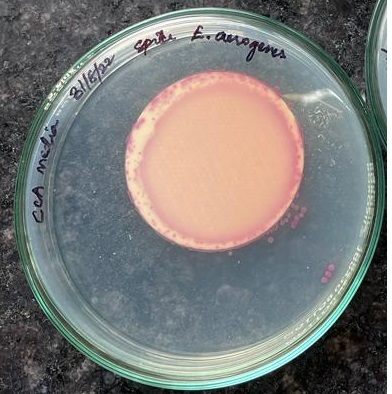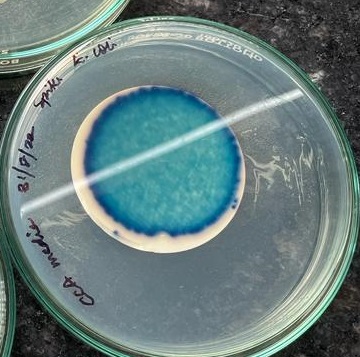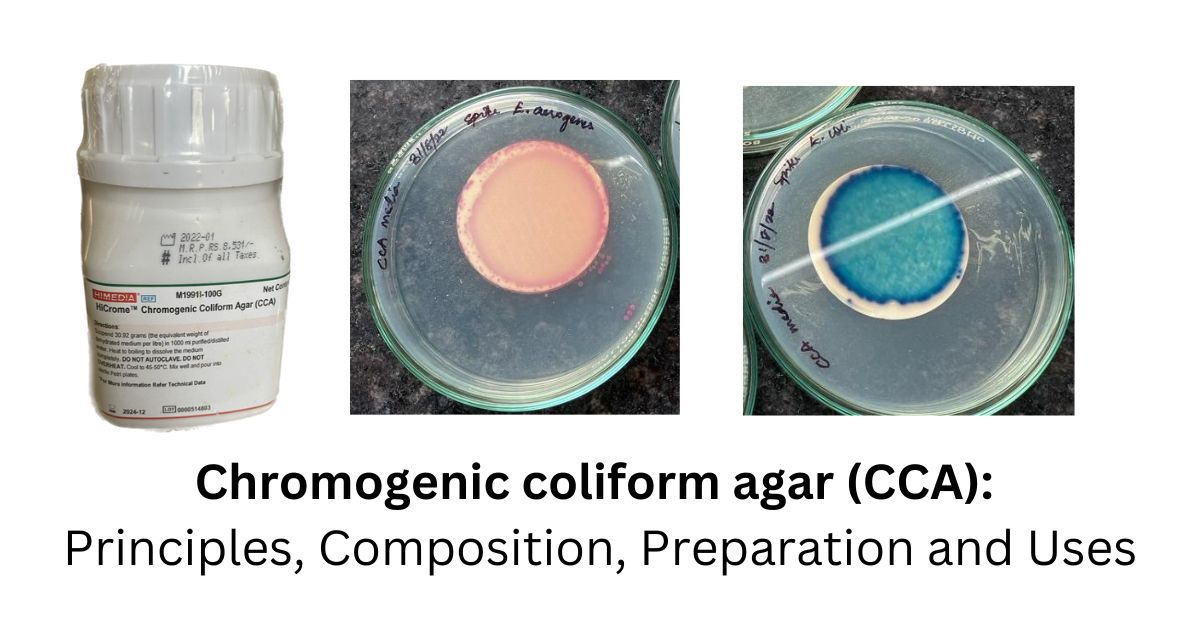Chromogenic coliform agar (CCA) is a selective and differential culture medium used for the Detection and Enumeration of Escherichia Coli and other coliform bacteria in water and other samples of low bacterial Background flora. The medium is designed to differentiate between coliform and non-coliform bacteria by their ability to produce specific enzymes that cleave the chromogenic substrates incorporated in the agar
Table of Contents
Chromogenic coliform agar principles
The principle of Hichrome Chromogenic coliform agar (CCA) is a fast and accurate way to detect E.coli and Coliform in drinking water samples by using Membrane Filtration Techniques. Counting of E.Coli and Coliform based on the ability of β-glucuronidase and β-galactosidase enzymes.
The medium contains 6-chloro-3-indoxyl-β-D-galactopyranoside is cleaved by β-D-galactosidase and produces pink to red color colonies this enzyme is associated with Coliform bacteria.
E.Coli produce β-D-glucuronidase enzymes that cleave both the chromogens (5 -bromo-4chloro-3-indoxyl-β-D-glucuronic and 6-chloro-3-indoxyl-β-D-galactopyranoside) resulting in the production of dark blue to violet colored colonies. The color of the colonies is indicative of the type of enzyme produced and the type of coliform bacteria present in the sample
Chromogenic coliform agarComposition
The CCA Culture media composition varies from Manufacturer to manufacturer. The given below composition is a reference to Himedia
| Composition | Amount in gm/L |
| Tryptone | 1 |
| Yeast extract | 2 |
| Sodium chloride | 5 |
| Sodium dihydrogen phosphate, 2H2O | 2.2 |
| Disodium hydrogen phosphate | 2.7 |
| Sodium pyruvate | 1 |
| Sorbitol | 1 |
| Tryptophan | 1 |
| Tryptophan | 0.15 |
| 6-chloro-3-indoxyl β-D-galactopyranoside | 0.200 |
| 5-bromo-4-chloro-3-indoxyl- β-D-glucuronic acid cyclohexlamine ammonium salt, monohydrate | 0.100 |
| IPTG (Isopropyl-β-D-thiogalactopyranoside) | 0.100 |
| Agar | 15 |
| Final pH at (250C) | 6.8±0.2 |
CCA media composition and their functions:
- Tryptone, sodium pyruvate, and sorbitol provide nitrogenous substances, fermentable carbohydrates,s, and other essential growth nutrients for the organisms
- Phosphates buffer the medium
- Tergitol-7 inhibits gram-positive as well as some gram-negative bacteria other than coliforms.
- IPTG (Isopropyl-β-D-thiogalactopyranoside) enhances the color reaction
- 6-chloro-3-indoxyl β-D-galactopyranoside cleaves by β-D-galactosidase enzyme to form red to pink colonies (Coliform)
- 5-bromo-4-chloro-3-indoxyl- β-D-glucuronic acid and 6-chloro-3-indoxyl β-D-galactopyranoside is cleaves by β-D-glucuronidase enzymes to produce Dark blue to violet (E.Coli)
- Agar is a solidifying agent
Chromogenic coliform agar Preparation
The preparation of CCA involves the following steps:
- Add 30.92 g of CCA powder to 1 liter of distilled water and mix well.
- Heat the mixture until the powder is completely dissolved.
- Cool the medium to 45-50°C and pour into sterile Petri dishes.
- *Do not Autoclave, Do not overheat
Chromogenic coliform agar Test Procedure
The test can be performed by plate count method or Membrane filtration Techniques. Here we are going to discuss membrane filtration Techniques. The test procedure for CCA involves the following steps:
- Take 100 ml (or other volumes eg. 250 ml) of water and filter by Using Membrane Filtration Assembly.
- Take out the filter aseptically and place it on CCA Media ensuring that no air is trapped underneath
- Incubate the inoculated CCA Plates aerobically in an inverted position at 360C for 24-48 hours
- After incubation observed plates for the presence of the colored colonies of E.Coli and Other Coliform Bacteria
Result and Interpretation


Chromogenic coliform agar Uses
- The uses of CCA include the detection and enumeration of E.Coli and other coliform bacteria in water, food, and environmental samples.
- The medium is highly specific for coliform bacteria and can detect the presence of Escherichia coli (E. coli), a common indicator of fecal contamination.
- CCA can also be used to differentiate between E. coli and other coliform bacteria such as Klebsiella and Enterobacter, which do not produce β-glucuronidase.
Chromogenic coliform agar price in Himedia
The price of CCA in Himedia varies depending on the quantity and packaging. Typically, a 100-gram bottle of CCA costs around INR 8531/-, However, the prices may vary depending on the supplier and location.
Conclusion
In conclusion, CCA is a useful medium for the detection of E.coli and other coliform bacteria in water and other samples. The medium is easy to prepare and use and provides a reliable method for the enumeration of coliform bacteria. The incorporation of chromogenic substrates in the medium allows for the differentiation of coliform and non-coliform bacteria based on their ability to produce specific enzymes
Reference
- Himedia Laboratories. Chromogenic Coliform Agar. https://www.himedialabs.com/TD/M1685.pdf
Frequently Asked Questions (FAQs)
Why the process of chromogenic coliform agar preparation are different from other medium?
The process of chromogenic coliform Agar preparation is different. Other media preparation is sterilized by using Autoclave while CCA media is not autoclavable because it has an enzyme in its composition it will be denature in Autoclave or overheat
Is CCA used for Coliform?
Yes, CCA Media is used for the enumeration and detection of E.Coli and other coliform bacteria
What is Chromogenic Coliform Agar (CCA)?
Chromogenic Coliform Agar (CCA) is a Selective agar medium used to detect the presence of coliform bacteria in water and other samples. The medium contains chromogenic substrates that allow for the differentiation of coliform and non-coliform bacteria based on their ability to produce specific enzymes
